Maui Whale Watching Season: A Guide to Best Tours & Viewing
Are you looking for the Ultimate Maui Whale Watching information? Look no further; I have all the information compiled here for you to have a wonderful whale-watching experience.
Maui, known as the Valley Isle, offers an incredible experience between December and April, the peak season for whale watching. During this period, the warm waters surrounding the island become a playground for humpback whales. These magnificent creatures migrate annually from the cold Alaskan waters to mate, give birth, and nurse their calves in the relative safety of Maui’s shallow seas.
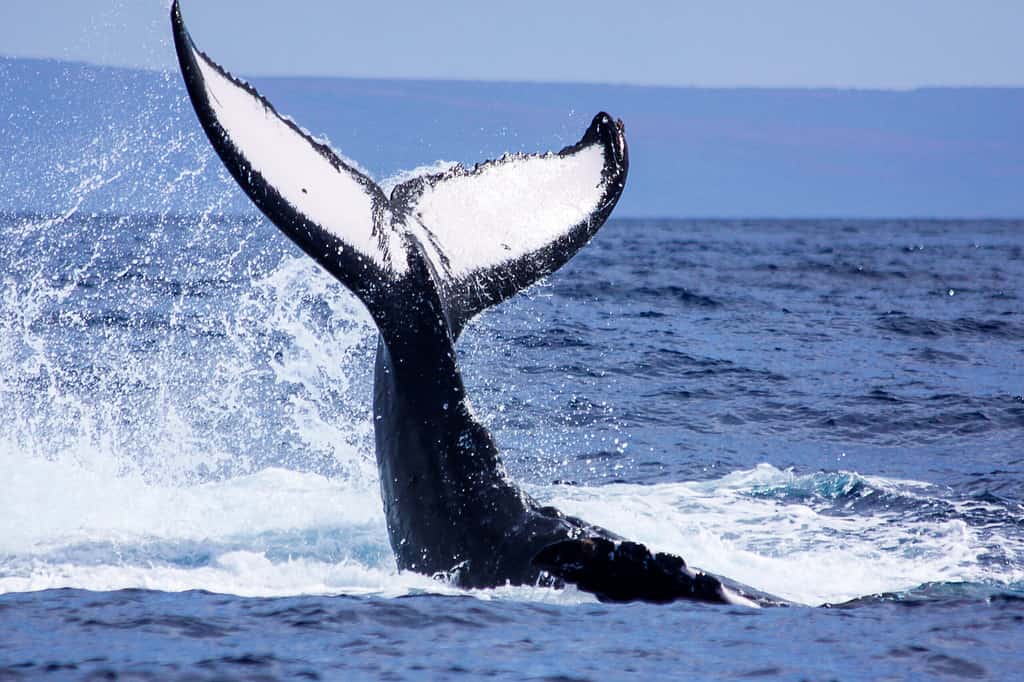
When you embark on a whale-watching tour in Maui, expect to witness these gentle giants breach the ocean’s surface, showcasing their incredible size and power. The coastal waters off Maui provide one of the best vantage points in the world to observe humpback whales in their natural habitat. With the West Maui Mountains and Haleakalā as your backdrop, the sight of the whales’ acrobatic displays is both majestic and awe-inspiring.
Your adventure at sea offers more than just watching; it is an opportunity to learn about the biology and behavior of humpback whales from knowledgeable guides. Conservation efforts to protect these marine mammals are also a focal point, making your experience memorable and educational. The clear Maui waters and the frequent sightings during this period mean you’ll likely have numerous encounters, so have your camera ready to capture these moments forever.
Affiliate Disclaimer: Some links on this blog are affiliate links. This means that, at no additional cost, the author may earn a small commission if you purchase through these links. As an Amazon Associate, I earn from qualifying purchases.
What Types of Whales Can Be Found in Maui
When you venture out to the waters surrounding Maui during whale-watching season, you’re primarily looking for North Pacific humpback whales. These magnificent creatures come to the warm Hawaiian waters yearly to mate, give birth, and nurse their young.
Aside from humpback whales, though not as common, you may also spot other species on rare occasions:
- False killer whales: Identified by the long, slender bodies that are black or dark gray in color.
- Sperm whales: Larger and darker, these whales have a distinctive block-shaped head.
- Minke whales: The smallest baleen whales have a pointed snout and a white band on each flipper.
Your whale-watching experience in Maui will mostly involve spotting the playful and acrobatic humpback whales, but keep your eyes peeled for these other infrequent visitors for a truly unique sighting!
Best Time for Whale Watching in Maui
The prime time for whale watching in Maui is during the winter and early spring when humpback whales migrate to the warm waters of Hawaii to breed and give birth.
Peak Season Highlights
- December to April: This period marks the peak whale watching season in Maui, with whale sightings at their highest.
- Abundance of Whales: From January to March, the waters around Maui teem with humpback whales.
Monthly Overview
| Month | Expectations |
| December | December 15th is the official beginning of whale watching season. There are good chances of sightings as whales start to arrive. |
| January | Sightings become consistent, with increased whale activity and breaches. |
| February | It is the peak within the peak season, with the highest number of whales. |
| March | Continuation of high activity, ideal for witnessing mother-calf pairs. |
| April | The end of the peak season is April 15th, with chances of sightings gradually decreasing. |
Whales can begin to arrive for the first time for the season in Maui as early as October or November. The official start of whale season is December 15th. Typically, by January, the migration to Hawaii is completed. Once the humpback calves gain enough strength and are ready for the 3000-mile journey to Alaska, the whales will start to leave Maui. The majority of the whales are gone by April 15th. There will be some stragglers, but they will all return to Alaska by the end of May for the summer months.
Best Time of Day to View Whales
Early morning and sunset are the best time to see them, especially from shore. Some scientific research suggests the males move to deeper waters in the afternoon to ensure their songs are heard. From 11:00 am to 3:00 pm, it has the best overhead light for seeing them near the boat if they approach. In reality, no time is bad during peak season whale season.
Planning Your Whale Watching Trip
Embarking on a whale-watching adventure in Maui is thrilling. Choosing the right tour and knowing what to pack is crucial for a memorable experience.
Choosing a Whale-Watching Tour
- Research Operators: Look for well-reviewed companies with experienced guides.
- Departure location: There are several locations that tours depart from, so make sure you know how far away they are from your accommodations.
- Maalaea Harbor – the most convenient location for those staying in South Maui
- Mala Ramp – is a great location to depart from if you are in West Maui. Due to the wildfire, access to it is restricted, but companies such as Hawaii Ocean Rafting and Captain Steve’s Rafting are departing from there.
- Ka’anapali Beach – many of the sunset cruises depart from the shore here.
- Lahaina Harbor is currently closed due to the devastation caused by the wildfire.
- Kihei boat ramp is small. Typically, this is used for small boats going to Molokini Crater.
- Type of Vessel: Decide if you prefer a larger boat for stability or a smaller one for closeness to the water.
- Tour Size: Tour sizes vary from 12 to 50 people.
- Tour Length: Tours can range from 2 hours to 4 hours.
- Check Schedules and Rates: Confirm tour timings and prices; they vary by season and company.
Essential Tips
- Look for white caps or mists coming off the water; it could be a whale breathing on the surface.
- Keep an eye out for a light turquoise color in the water: Whales give off a light turquoise reflection when near the surface.
What to Bring and Wear
Clothing: Dress in layers with a waterproof jacket; mornings can be cool.
Sun Protection: Bring sunglasses and a brimmed hat, and apply sunscreen beforehand.
Binoculars: Enhance your viewing experience with a pair to spot whales at a distance.
Camera: Charge your camera or phone to capture the majestic creatures.
Seasickness Medicine: Take preventive measures if you’re prone to motion sickness.
Best Whale Watching Tours
There are several options of vessels available for whale-watching tours.
- Catamarans
- Sailboat
- Raft – this is our preferred way.
- Kayaking & outrigger canoes are also options for sighting whales.
Our Recommendations for Catamaran Whale Watch Tours:
- Whale Watching from Ma’alaea Harbor
- Maui Whale Watching & Snorkeling Tour from Ma’alaea Harbor aboard Pride of Maui
Our Recommendations for Sailboat Whale Watch Tours:
Our Recommendations for Rafting Whale Watch Tours:
- 2-Hour Whale Watch Adventure – Our Top Choice
- Eye-Level Whale Watching Eco-Raft Tour
- Maui Whale-Watching Tour by Raft from Kihei
Our Recommendations for Kayaking Whale Watch Tours:
Essential Tips
Remember to tip your crew after your excursion. Bring cash, although some tour operators will have the option to Venmo.
Book tours at the beginning of your trip if it gets canceled due to weather. We have had this happen several times over the past 15 years. It would be disappointing not to get on the water to see these amazing creatures!
Whale watching and snorkeling
Some tours will take you both whale watching and snorkeling. Just be sure that you choose a tour that has your priorities. Don’t confuse a snorkel tour with a combo whale-watching and snorkeling tour. The time for the excursion is a good indication of the type of tour you are booking. If it’s two hours, it is not a whale and snorkel; it is just a snorkel.
In the past, we have done the combo tour with Captain Steve’s, and they do a great job combining snorkeling and whales. We have also done their whale watch-only tour.
We love whale watching so much that we have added a sunset cruise during our stay. Again, be careful about what you book. Make sure it is a WHALE watching sunset cruise vs. a regular sunset sail.
On our last trip, we were disappointed that the captain announced as we boarded that we would be sailing, not whale watching. We have used this company in the past for whale watching. Ultimately, it is up to your captain if it’s not designated a whale watch cruise. Book carefully.
Also, it should be noted that any snorkeling trip you do will NOT be in the water swimming near whales. Maui has strict regulations about getting close to whales versus other destinations/countries.
Understanding Maui’s Whale Migration
In this section, you’ll discover why humpback whales journey vast distances to reach the warm waters of Maui, their migration patterns, typical behaviors during their stay, and the ongoing efforts to protect them. The Hawaiian word for humpback whale is Kohola.
Why Humpback Whales Migrate to Maui
Every year, humpback whales migrate to Maui for breeding and birthing. Maui’s waters provide a haven with fewer predators, ensuring a higher survival rate for new calves. The warm temperatures are ideal for mothers and their young, as the calves lack the substantial blubber needed to insulate themselves in colder waters.
The next preferred island for humpback whales would be the Big Island. Although all islands will get some whales, Maui gets the most migration. The best place to see them is in the Au’au Channel, between Maui, Molokai, and Lanai.
Humpback Whale Migration Patterns
Humpback whales embark on a 3,000-mile journey from the cold waters of Alaska to the tropical climate of Hawaii. It takes them 4-6 weeks to make their way to Hawaii. They usually arrive in Maui from November to May, peak season from January to March. These whales are known for their punctual seasonal movement, although the exact timing varies yearly. It is estimated that 10,000 whales will visit Hawaii waters a year.
Humpback Whale Habits
During their stay, humpback whales engage in breeding and birthing activities. You’ll often witness males competing for females through spirited displays, such as breaching and tail slapping. Mothers with calves are commonly seen, and the calm waters of Maui provide an ideal environment for young whales to grow and gain strength for the journey back.
Only Male humpbacks sing a unique whale song that is different each year. All the males will sing the same song at the same time. Why they sing is not entirely known, but it is assumed it plays a role in mating.
It takes 11-12 months for a humpback whale to gestate. They will breed in Maui, travel back to Alaska for the summer months, then return to Maui to birth the calf. Mothers will not eat in Hawaii; they concentrate on nursing the calf. A humpback whale calf weighs 2000 lbs. and is 13-16 feet long at birth. It will gain approximately 100 lbs. daily and double its length in a year. Humpback whales reach sexual maturity between 4 -10 years of age. An average humpback whale weighs 80,000 lbs. or 40 tons!
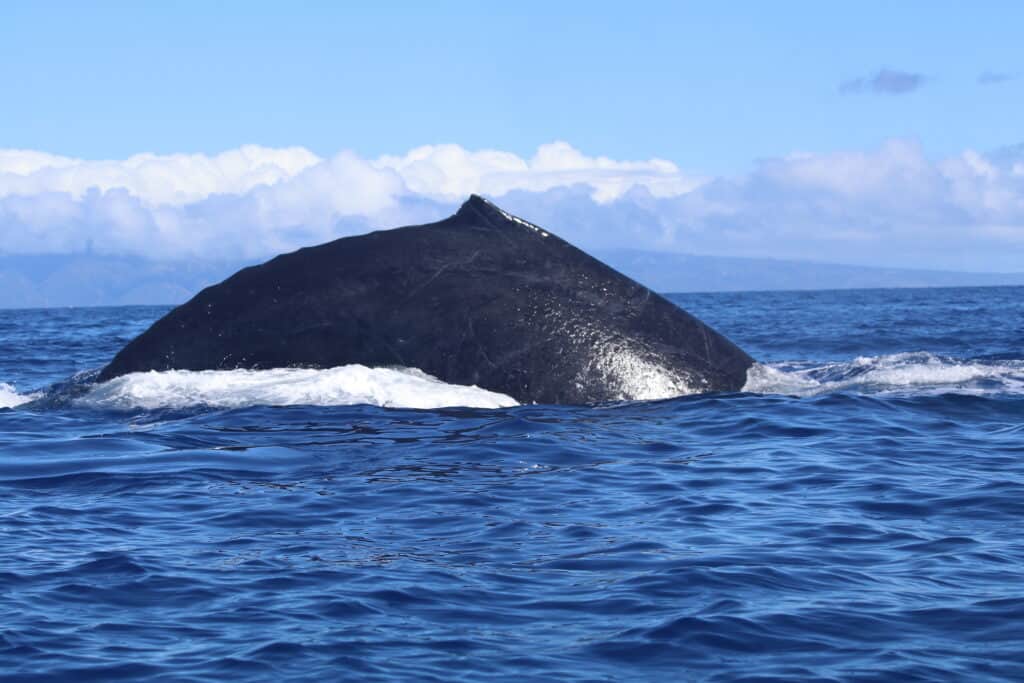
What makes Humpback Whales special?
Their tail has distinct markings that are like our fingerprints. Researchers use these markings as a way of tracking the whales. If you would like to upload your whale tail photo to have it be a part of the identification project, visit https://happywhale.com/home
Humpback whales reach maturity at 5-7 years and, on average, live to be 50 years old.
Whales learn skills in the Maui waters that will help their survival for the migration to Alaska.
We have been on boats where the whale would come to the boat to check us out or show its calf when we make noise. They are curious creatures!
Male Competition pods are common. Males fight for the affection of the females. The battles can be intense, trying to prove their strength to the females. Sometimes, a female allows a male around her to protect her from other males, especially if there is a calf.

Humpback Whale Activity
When you see a humpback’s tail, also known as a fluke, it signifies that they are diving down. During their dives, whales can stay underwater for up to 20 minutes. If you want to observe a humpback in this behavior, be patient and closely monitor their movements. Remember, their dives can be quite fascinating to witness!
A Tail Throw
A tail throw is a fascinating display of communication. With a swift and powerful motion, the female humpback whale slaps her tail against the water, creating a resounding splash that echoes through the tranquil surroundings. This unique behavior serves as a signal, a way for the female to capture the attention of the male counterpart. Tail slaps showcases the dynamics and rituals of whales in their search for a mate.
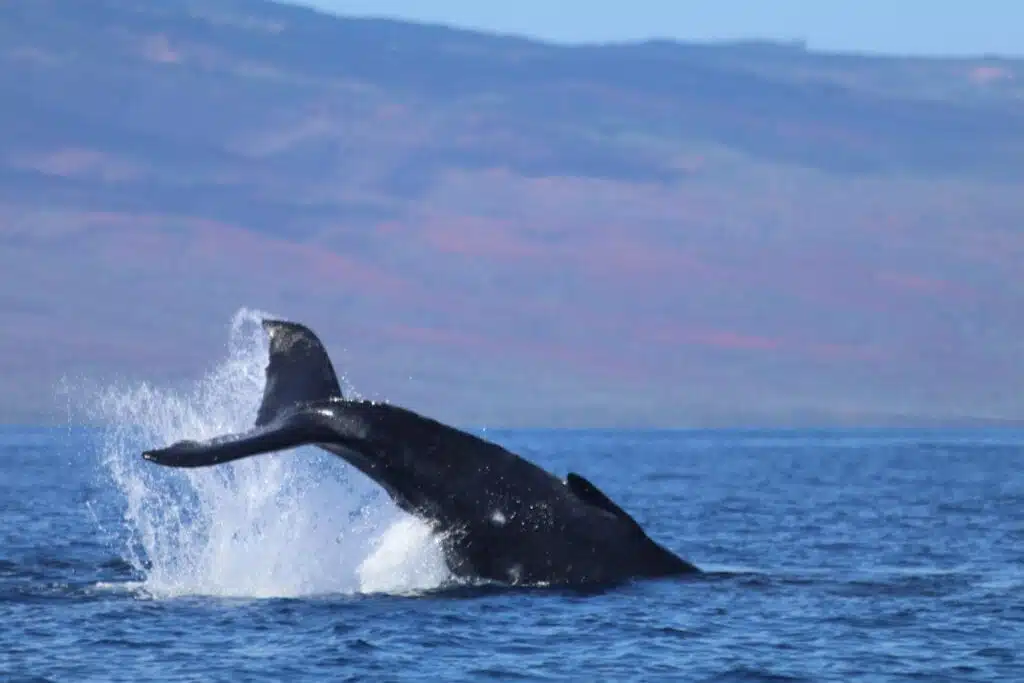
A Spy Hop
The spy hop behavior is fascinating to observe in whales. It involves the majestic creature floating its massive head out of the water to get a better view of its surroundings. This behavior allows the whale to look at what’s happening above the surface and gather valuable information about its environment. Spy hopping offers a glimpse into the intelligence and curiosity of these magnificent animals. It’s truly a remarkable sight to witness.
Pec Slaps
Pectoral slaps, commonly called “pec slaps,” are an intriguing form of communication observed in humpback whales. This behavior involves the animal lifting its pectoral fin out of the water and slapping it forcefully against the surface, creating a loud sound and visible splash. In the case of humpback whales, females may use the pec slap as a non-vocal method to signal their presence and attract the attention of potential male mates. The sound produced by the slap can travel long distances underwater, making it an effective way to communicate over the vast expanses of the ocean.
The pec slap can also serve as a social interaction, play, and even a deterrent to predators or other threats. Witnessing a whale on the surface of the water do a series of pec slaps is a captivating experience showing how humpbacks interact and communicate in their environment.
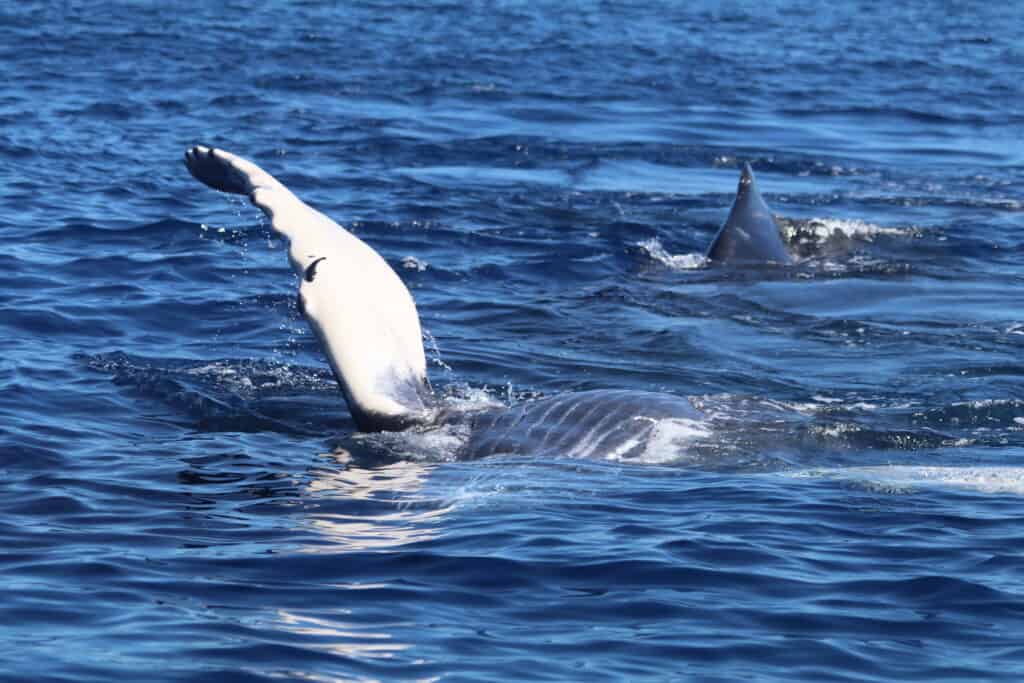
Being Mugged by a Humpback
The term “mugging” is where the whale approaches a boat closely, often within 100 yards, on its own initiative. This behavior can be a thrilling experience for whale watchers, allowing for a close-up view and interactions with these magnificent creatures. It’s important to note that regulations require vessels to maintain a 100-foot distance from whales to ensure their safety and prevent disturbances in their natural behavior. However, if a whale decides to come close of its own accord, this is typically allowed and is known as a “mugging” by the whale. It demonstrates the curiosity and intelligence of the whales and provides researchers and enthusiasts with a unique opportunity to observe them.
The close encounters of a spy hop and a mugging are once-in-a-lifetime experiences that you will never forget if you have a chance to encounter them.

What Humpback Whales Eat
When humpback whales are in the cold waters of Alaska and Russia, they feed on krill, squid, herring, and other small fish. Once in Maui, they don’t eat but use their fat reserves.
Conservation Efforts
Efforts to safeguard humpback whales include enforced regulations on whale watching to prevent disturbances, research initiatives to understand their health and behaviors, and public education programs to promote awareness. Sanctuaries and marine protected areas have been established to ensure the whales’ habitat remains pristine and supports their lifecycle needs.
In the 90s, the Maui Nui Basin became a protected sanctuary for humpback whales. Activities that endanger the whales, such as parasailing and jet skis, are prohibited from Dec 15 to April 15. Boats cannot get 100 feet of a whale. Vessels must turn off their engines and wait for the whale to leave the area. Sometimes, the whale will approach the boat alone during this time.
On a memorable sunset cruise, our boat was surrounded by whales on three sides. Because of this, we could not move until the whales were 100 feet away from the boat. While we were getting a wonderful show of breeches and a mama whale with her day-old calf, it posed a problem for our captain. Boats need to be back to shore at a certain time of sunset, and we were getting dangerously close to a time that they would be fined. Luckily, the whales knew it was time to move on, clearing us to dock in time.
Spotting Whales from Shore
When visiting Maui during the whale-watching season, you can spot whales right from the shore. Although the best way to see them is on a whale watch tour, they can also be enjoyed from the shore.
Be careful driving the Highway along the ocean and being distracted by the whales. There are lookouts along the highway for you to stop and view these amazing creatures.
I will never forget our first trip to Maui, driving from the airport to Ka’anapali, pulling into the Papawai Point, and seeing humpback whales breach. That was the start of my family’s love of Maui and visiting this time of year.
Best Locations
Papawai Point: One of the most popular lookout points, offering panoramic ocean views where humpback whales are frequently seen.
Kapalua Coastal Trail: A scenic walking trail with several spots where whales can often be spotted breaching.
Merriman’s in Napili: One of the best places to enjoy a meal and see whales at sunset.
List of Top Shore-Based Whale Watching Spots:
- Papawai Point
- Kapalua Coastal Trail
- McGregor Point Lookout
- Ka’anapali Beach
- Olowalu Beach
- Kihei’s Beach Parks
- Wailea’s Coastal Path
Tips for Land-Based Watching
Time of Day: Early morning or late afternoon provides the best lighting for whale sightings.
Equipment: Bring binoculars for a closer view or a camera with a zoom lens to capture the action.
Essential Tips:
1. Stay patient; whale behaviors are unpredictable.
2. Look for signs of whale activity, like spouts or mists of water.
3. Respect wildlife viewing guidelines and keep a safe distance.
Maui’s Marine Wildlife
While enjoying the scenery above water, Maui also offers a fascinating world of marine life below the surface.
Other Marine Animals
Maui’s waters are a sanctuary for a variety of marine animals. Sea turtles and dolphins frequently accompany the humpback whales. You may also encounter monk seals or spot a vibrant school of tropical fish near the coral reefs.
Sea Turtles: Often found in shallower waters near the coast.
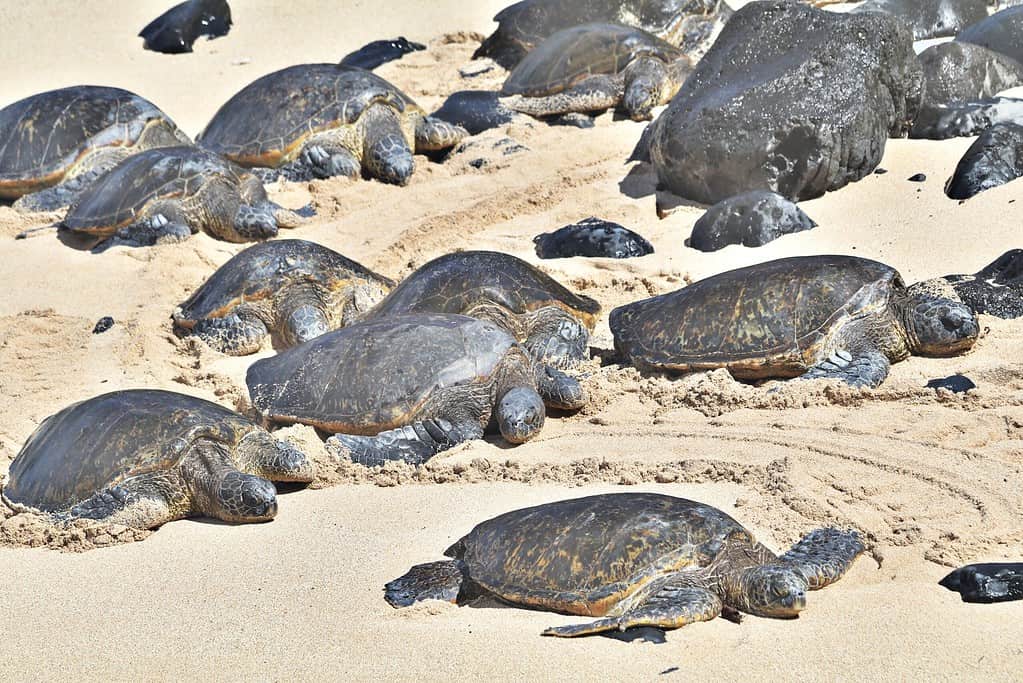
Dolphins: Spinner and bottlenose dolphins can often be seen playing in the wake of boats—the best place to happen upon spinner dolphins is off the shores of Lanai.
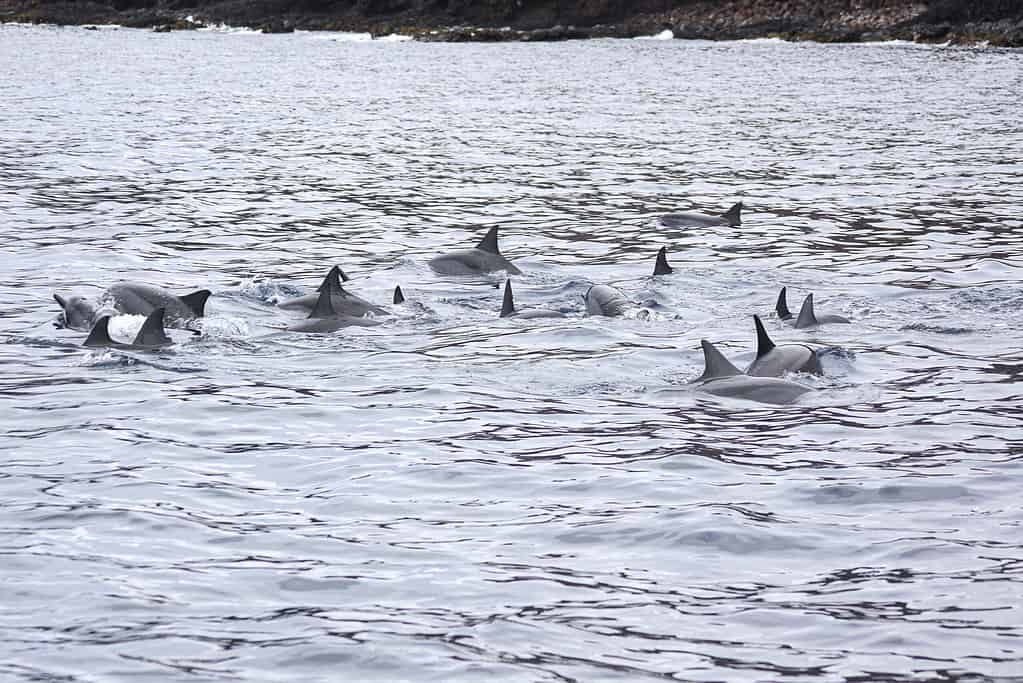
Monk Seals: Endangered species that occasionally rest on beaches or forage near the shorelines.
Tropical Fish: Home to numerous species, including the state fish, the Humuhumunukunukuapua’a.
Marine Habitats
The habitats around Maui are as diverse as the creatures that call them home. Coral reefs create an ecosystem rich in food and shelter for marine life. The deeper waters off the coast, often called the Pelagic Zone, offer a vast expanse for migratory species like whales.
Coral Reefs: Nearshore environments teeming with sea life.
Pelagic Zone: The open ocean water is not near the bottom or shore.
CT Tip: Listen to the male humpback whale “songs while underwater.” If you are snorkeling in the waters of Kahekili or Ka’anapali, there is a good possibility you will be able to hear them sing.
When is the best time to visit Maui?
The heart-stopping display of breaching humpback whales is synonymous with the Hawaiian island, and winter months — including February and March — offer the most splendid opportunities. But even if the winter schedule doesn’t align with yours, or if whale watching isn’t high on your list, Maui has something for everyone, especially in the less crowded shoulder seasons of May, June, September, and October. The island’s consistently mild climate makes any time a good visit. Whether you’re a sports enthusiast, an ocean lover, or need a tropical retreat, every season on Maui unfolds new adventures and soul-soothing vistas. Prepare for various experiences, from pristine beaches and lush rainforests to the vibrant local culture, where every day on Maui is well-spent.
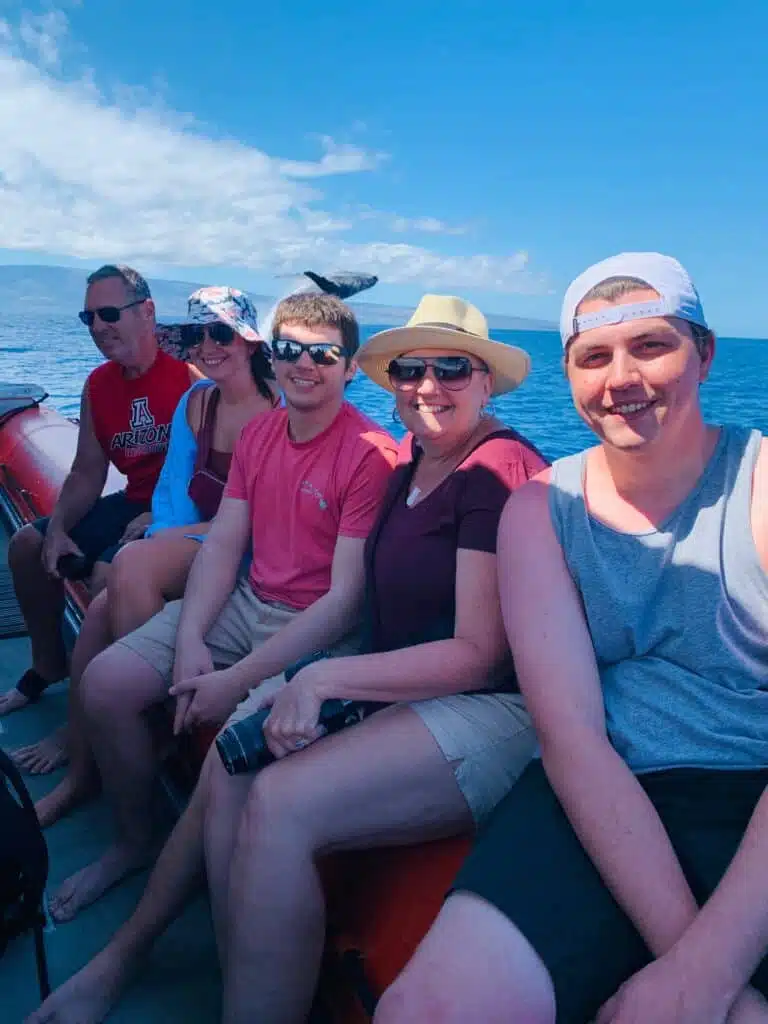
Our once-in-a-lifetime family picture was taken while we were on a whale watch with Captain Steve’s Rafting with a humpback whale photo bombing us while it breaches.
Final Thoughts on Maui Whale Watch Season
The beautiful songs of the male whales echo through the waters, a signature sound of the North Pacific humpback whale population that calls the Hawaiian Islands Humpback Whale National Marine Sanctuary home during these magical months. From the first whale sighting, typically heralding the start of the season, to the sight of newborn calves alongside their mothers, the annual migration of these majestic creatures to the warm and shallow waters around Maui is nothing short of spectacular. Baby humpbacks, easily identified by their smaller size and close proximity to adult whales, delight onlookers with their playful antics, often breaching the water’s surface or slapping their pectoral fins to display youthful exuberance practicing new skills.
Marine naturalists and marine biologists aboard various whale watches provide invaluable insights into whale behavior, enhancing the experience for those aboard boat tours. Large boats, like the Pride of Maui, and smaller vessels, like Captain Steve’s Rafting, have offered these educational excursions, catering to different preferences, whether one desires the stability of a large craft or the intimacy of smaller groups that smaller boats provide.
Areas around Lahaina and Maalaea Harbors have proven to be one of the best spots for these encounters, giving whale watchers the best chance to see these beautiful creatures up close. Maui is the best Hawaiian island for this experience, especially during the best months of the season. The island’s unique position provides an excellent opportunity for sightings, as most whales choose the island’s protected waters for breeding and birthing.
The Ultimate Whale-Watching Season
Maui’s whale season is an opportunity to witness the annual migration and immerse oneself in Hawaiian culture and the deep respect it holds for these animals. The National Oceanic and Atmospheric Administration and dedicated marine scientists work tirelessly to protect the humpback whales, known scientifically as Megaptera novaeangliae, as they navigate from their feeding grounds to the Hawaiian sanctuary.
For those seeking the best whale-watching experience, visiting the island of Maui during peak whale season promises a once-in-a-lifetime experience. Whether it’s your first or your fiftieth time, the thrill of seeing these giants of the ocean never fades. I hope this helps you plan your ultimate whale watch while visiting Maui during whale season.
Frequently Asked Questions
In this section, you’ll find key information to help you plan an unforgettable whale-watching experience in Maui.
The peak whale watching season in Maui is from January to March. During this time, humpback whales are most abundant and active in the surrounding waters.
Yes, it’s possible to see whales in Maui during November as the whale watching season typically begins in mid-fall. However, sightings are less frequent compared to the peak season.
Maui’s west and south shores, particularly those surrounding Lahaina and Kihei, are renowned for offering some of the best whale-watching experiences.
Maui whale-watching tours are often preferred due to the higher concentration of whales in the Maui Nui Basin. Maui’s tours are also more frequent and varied due to the many visitors seeking this activity.
Yes, several tours have earned high praise for their whale-watching experiences. Pacific Whale Foundation and Trilogy Excursions are among the top-rated for their knowledgeable staff and dedication to marine life conservation. We also recommend Captain Steve’s for a smaller vessel experience.
The Maui Nui Basin is a shallow, warm body of water between Maui, Lanai, and Molokai. It is a major breeding and calving area for humpback whales, making it a premier whale-watching destination.
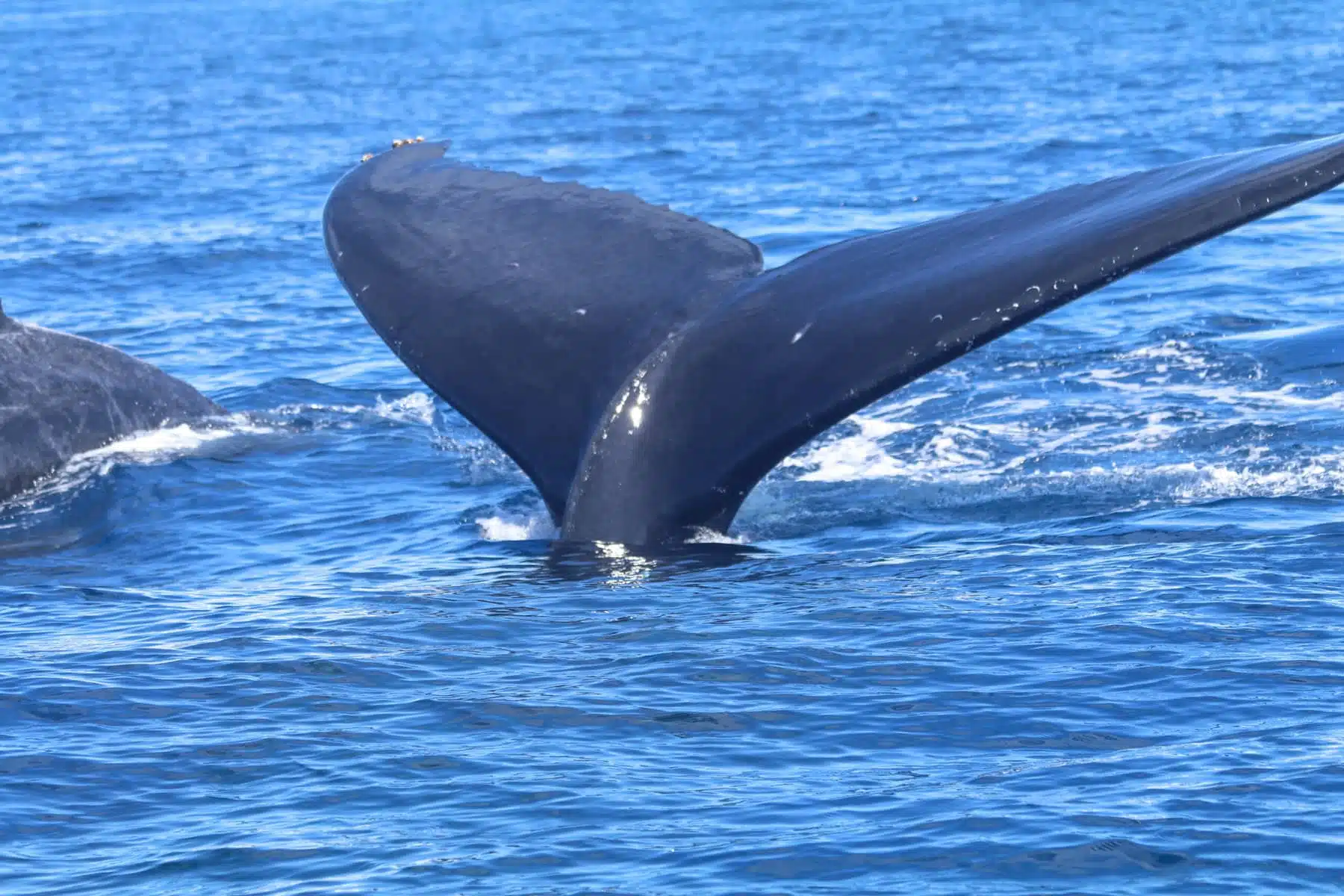

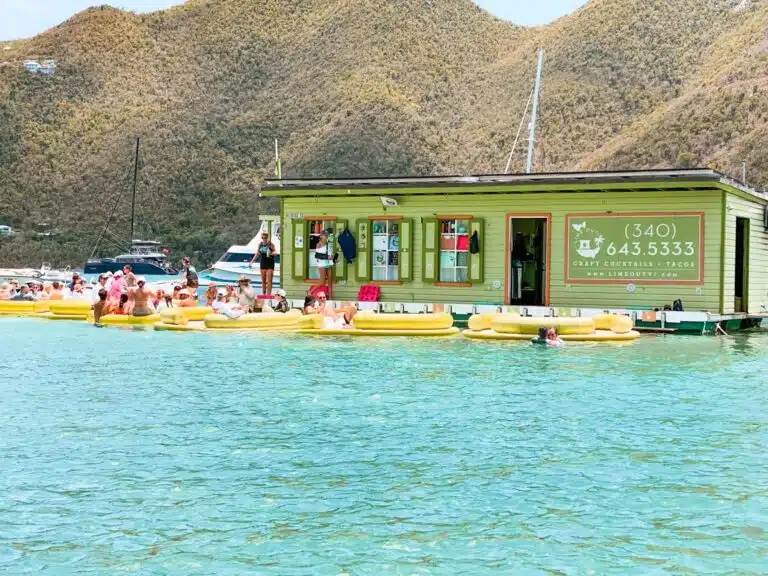




Great article! Love the concise tips and focus on conservation in Maui’s whale watching guide. It’s a fantastic resource for anyone eager to witness these majestic creatures.
Thank you! We absolutely love seeing the humpbacks in Maui. We went to Alaska once, but we found we loved seeing them in Maui with their calves.
I have seen whales in the wild along the Australia coastline but this would be something else to see them in Hawaii. Thank you for providing all the details to seeing these beautiful creatures.
I had no idea that there was a preferred time for whale watching or that different motions, like the pec slap, are ways of communicating. Your blog post is so informative!
Fab! I definitely want to see the Whales when I visit… and I guess I’m in luck because I absolutely love traveling during February and March, so it’s perfect. Thanks for all the tips!
What a great post! I went whale watching in Iceland last year and saw many. I tried in Madeira too and saw nothing but water hahaha